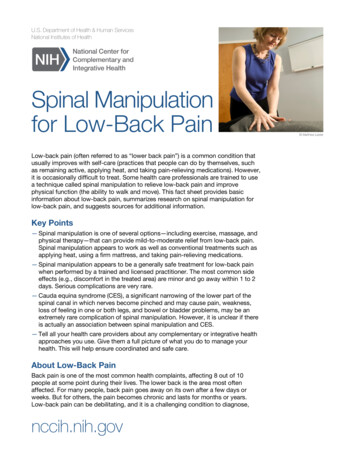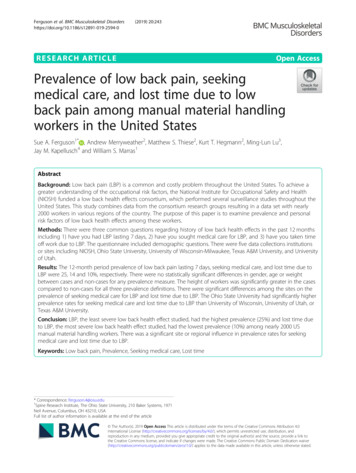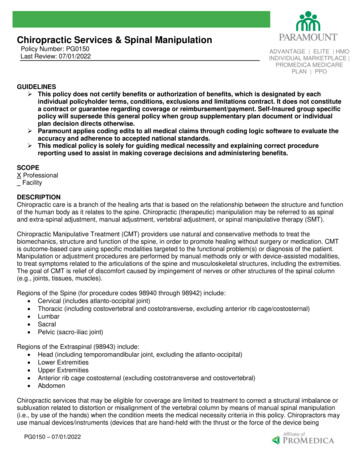
Transcription
U.S. Department of Health & Human ServicesNational Institutes of HealthSpinal Manipulationfor Low-Back PainLow-back pain (often referred to as “lower back pain”) is a common condition thatusually improves with self-care (practices that people can do by themselves, suchas remaining active, applying heat, and taking pain-relieving medications). However,it is occasionally difficult to treat. Some health care professionals are trained to usea technique called spinal manipulation to relieve low-back pain and improvephysical function (the ability to walk and move). This fact sheet provides basicinformation about low-back pain, summarizes research on spinal manipulation forlow-back pain, and suggests sources for additional information.Key Points— Spinal manipulation is one of several options—including exercise, massage, andphysical therapy—that can provide mild-to-moderate relief from low-back pain.Spinal manipulation appears to work as well as conventional treatments such asapplying heat, using a firm mattress, and taking pain-relieving medications.— Spinal manipulation appears to be a generally safe treatment for low-back painwhen performed by a trained and licensed practitioner. The most common sideeffects (e.g., discomfort in the treated area) are minor and go away within 1 to 2days. Serious complications are very rare.— Cauda equina syndrome (CES), a significant narrowing of the lower part of thespinal canal in which nerves become pinched and may cause pain, weakness,loss of feeling in one or both legs, and bowel or bladder problems, may be anextremely rare complication of spinal manipulation. However, it is unclear if thereis actually an association between spinal manipulation and CES.— Tell all your health care providers about any complementary or integrative healthapproaches you use. Give them a full picture of what you do to manage yourhealth. This will help ensure coordinated and safe care.About Low-Back PainBack pain is one of the most common health complaints, affecting 8 out of 10people at some point during their lives. The lower back is the area most oftenaffected. For many people, back pain goes away on its own after a few days orweeks. But for others, the pain becomes chronic and lasts for months or years.Low-back pain can be debilitating, and it is a challenging condition to diagnose,nccih.nih.gov Matthew Lester
National Center for Complementary and Integrative HealthSpinal Manipulation for Low-Back Paintreat, and study. The total annual costs of low-back pain in the United States—including lost wages and reduced productivity—are more than 100 billion.About Spinal ManipulationSpinal manipulation—sometimes called “spinal manipulative therapy”—is practiced byhealth care professionals such as chiropractors, osteopathic physicians, naturopathicphysicians, physical therapists, and some medical doctors. Practitioners performspinal manipulation by using their hands or a device to apply a controlled force to ajoint of the spine. The amount of force applied depends on the form of manipulationused. The goal of the treatment is to relieve pain and improve physical functioning.Side Effects and RisksReviews have concluded that spinal manipulation for low-back pain is relatively safewhen performed by a trained and licensed practitioner. The most common sideeffects are generally minor and include feeling tired or temporary soreness.Reports indicate that cauda equina syndrome (CES), a significant narrowing of the lowerpart of the spinal canal in which nerves become pinched and may cause pain, weakness,loss of feeling in one or both legs, and bowel or bladder problems, may be an extremelyrare complication of spinal manipulation. However, it is unclear if there is actually anassociation between spinal manipulation and CES, since CES usually occurs withoutspinal manipulation. In people whose pain is caused by a herniated disc, manipulation ofthe low back appears to have a very low chance of worsening the herniation.For risks associated with spinal manipulation affecting the upper (cervical) spine,see the NCCIH fact sheet Chiropractic.What the Science Says About Spinal Manipulation for LowBack PainOverall, studies have shown that spinal manipulation is one of several options—including exercise, massage, and physical therapy—that can provide mild-tomoderate relief from low-back pain. Spinal manipulation also appears to work aswell as conventional treatments such as applying heat, using a firm mattress, andtaking pain-relieving medications.In 2007 guidelines, the American College of Physicians and the American Pain Societyincluded spinal manipulation as one of several treatment options for practitioners toconsider when low-back pain does not improve with self-care. More recently, a 2010Agency for Healthcare Research and Quality (AHRQ) report noted that complementaryhealth therapies, including spinal manipulation, offer additional options to conventionaltreatments, which often have limited benefit in managing back and neck pain. TheAHRQ analysis also found that spinal manipulation was more effective than placeboand as effective as medication in reducing low-back pain intensity. However, theresearchers noted inconsistent results when they compared spinal manipulation withmassage or physical therapy to reduce low-back pain intensity or disability.Researchers continue to study spinal manipulation for low-back pain.— A 2011 review of 26 clinical trials looked at the effectiveness of differenttreatments, including spinal manipulation, for chronic low-back pain. The authors2
National Center for Complementary and Integrative HealthSpinal Manipulation for Low-Back Painconcluded that spinal manipulation is as effective as other interventions forreducing pain and improving function.— A 2010 review that looked at various manual therapies, such as spinalmanipulation and massage, for a range of conditions found strong evidence thatspinal manipulation is effective for chronic low-back pain and moderate evidenceof its effectiveness for acute low-back pain.— A 2009 analysis looked at the evidence from 76 trials that studied the effects ofseveral conventional and complementary health practices for low-back pain. Theresearchers found that the pain-relieving effects of many treatments, including spinalmanipulation, were small and were similar in people with acute or chronic pain.— A 2008 review that focused on spinal manipulation for chronic low-back pain foundstrong evidence that spinal manipulation works as well as a combination of medicalcare and exercise instruction, moderate evidence that spinal manipulation combinedwith strengthening exercises works as well as prescription nonsteroidal antiinflammatory drugs combined with exercises, and limited-to-moderate evidence thatspinal manipulation works better than physical therapy and home exercise.Researchers are investigating whether the effects of spinal manipulation depend on thelength and frequency of treatment. In one study funded by NCCIH that examined longterm effects in more than 600 people with low-back pain, results suggested thatchiropractic care involving spinal manipulation was at least as effective as conventionalmedical care for up to 18 months. However, less than 20 percent of participants in thisstudy were pain free at 18 months, regardless of the type of treatment used.Researchers are also exploring how spinal manipulation affects the body. In anNCCIH-funded study of a small group of people with low-back pain, spinalmanipulation affected pain perception in specific ways that other therapies(stationary bicycle and low-back extension exercises) did not.Managing Low-Back PainA review of evidence-based clinical guidelines for managing low-back pain resultedin several recommendations for primary care physicians and pointed to potentialbenefits of nondrug therapies including spinal manipulation, as well as exercise,massage, and physical therapy:— Acute low-back pain: Routine imaging (x-rays or MRIs) generally is notnecessary for patients who have had nonspecific low-back pain for a short time.These patients often improve on their own and usually should remain active, learnabout back pain and self-care options, and consider nondrug therapies, includingspinal manipulation, if pain persists longer than 4 weeks.— Chronic low-back pain: Long-term use of opioid drugs usually does not improvefunctioning for patients with chronic low-back pain. However, these patients maybenefit from nondrug therapies, including spinal manipulation. Psychological and socialfactors also may play a role in chronic low-back pain. Most patients will not becomepain free; a realistic outlook focuses on improving function in addition to reducing pain.To learn more, see the NCCIH Research Spotlight “Managing Low-Back Pain: AnEvidence-Based Approach for Primary Care Physicians” on the NCCIH Web site.3
National Center for Complementary and Integrative HealthSpinal Manipulation for Low-Back PainNCCIH-Funded ResearchRecent NCCIH-supported projects have been investigating:— The biomechanisms of spinal manipulation—detailed studies of what happens inthe body during manipulation of the low back— The best number and frequency of treatments, and the length of care— Estimated use, costs, and outcomes of chiropractic care for recurrent back pain.For More InformationNCCIH ClearinghouseThe NCCIH Clearinghouse provides information on NCCIH and complementary andintegrative health approaches, including publications and searches of Federaldatabases of scientific and medical literature. The Clearinghouse does not providemedical advice, treatment recommendations, or referrals to practitioners.Toll-free in the U.S.: 1–888–644–6226TTY (for deaf and hard-of-hearing callers): 1–866–464–3615Web site: nccih.nih.govE-mail: info@nccih.nih.govNational Institute of Arthritis and Musculoskeletal and Skin Diseases (NIAMS)The mission of NIAMS is to support research into the causes, treatment, andprevention of arthritis and musculoskeletal and skin diseases; the training of basicand clinical scientists to carry out this research; and the dissemination ofinformation on research progress in these diseases.Toll-free in the U.S.: 1-877-22-NIAMSWeb site: www.niams.nih.gov/PubMed A service of the National Library of Medicine (NLM), PubMed contains publicationinformation and (in most cases) brief summaries of articles from scientific andmedical journals. For guidance from NCCIH on using PubMed, see How To FindInformation About Complementary Health Approaches on PubMed.Web site: www.ncbi.nlm.nih.gov/pubmedNIH Clinical Research Trials and YouThe National Institutes of Health (NIH) has created a Web site, NIH Clinical ResearchTrials and You, to help people learn about clinical trials, why they matter, and howto participate. The site includes questions and answers about clinical trials,guidance on how to find clinical trials through ClinicalTrials.gov and other resources,and stories about the personal experiences of clinical trial participants. Clinical trialsare necessary to find better ways to prevent, diagnose, and treat diseases.Web site: www.nih.gov/health/clinicaltrials/4
National Center for Complementary and Integrative HealthSpinal Manipulation for Low-Back PainResearch Portfolio Online Reporting Tools Expenditures & Results (RePORTER)RePORTER is a database of information on federally funded scientific and medicalresearch projects being conducted at research institutions.Web site: projectreporter.nih.gov/reporter.cfmKey ReferencesBialosky JE, Bishop MD, Robinson ME, et al. Spinal manipulative therapy has an immediate effect onthermal pain sensitivity in people with low back pain: a randomized controlled trial. PhysicalTherapy. 2009;89(12):1292-1303.Bronfort G, Haas M, Evans R, et al. Effectiveness of manual therapies: the UK evidence report. Chiropractic& Osteopathy. 2010;18(3):1-33.Bronfort G, Haas M, Evans R, et al. Evidence-informed management of chronic low back pain with spinalmanipulation and mobilization. Spine Journal. 2008;8(1):213-225.Bronfort G, Haas M, Evans RL, et al. Efficacy of spinal manipulation and mobilization for low back pain andneck pain: a systematic review and best evidence synthesis. Spine Journal. 2004;4(3):335-356.Cagnie B, Vinck E, Beernaert A, et al. How common are side effects of spinal manipulation and can theseside effects be predicted? Manual Therapy. 2004;9(3):151-156.Cherkin DC, Sherman KJ, Deyo RA, et al. A review of the evidence for the effectiveness, safety, and cost ofacupuncture, massage therapy, and spinal manipulation for back pain. Annals of InternalMedicine. 2003;138(11):898-906.Chou R, Huffman LH. Nonpharmacologic therapies for acute and chronic low-back pain: a review of theevidence for an American Pain Society/American College of Physicians clinical practice guideline. Annalsof Internal Medicine. 2007;147(7):492-504.Chou R, Qaseem A, Snow V, et al. Diagnosis and treatment of low-back pain: a joint clinical practiceguideline from the American College of Physicians and the American Pain Society. Annals of InternalMedicine. 2007;147(7):478-491.Dagenais S, Tricco AC, Haldeman S. Synthesis of recommendations for the assessment and managementof low back pain from recent clinical practice guidelines. Spine Journal. 2010;10(6):514–529.Elder WG Jr, King M, Dassow P, et al. Managing lower back pain: you may be doing too much. Journal ofFamily Practice. 2009;58(4):180–186.Ferreira ML, Ferreira PH, Latimer J, et al. Comparison of general exercise, motor control exercise and spinalmanipulative therapy for chronic low back pain: a randomized trial. Pain. 2007;131(1-2):31-37.Ferreira ML, Ferreira PH, Latimer J, et al. Efficacy of spinal manipulative therapy for low back pain of lessthan 3 months’ duration. Journal of Manipulative and Physiological Therapeutics. 2003;26(9):593-601.Furlan A, Yazdi F, Tsertsvadze A, et al. Complementary and Alternative Therapies for Back Pain II. EvidenceReport/Technology Assessment, no. 194. Rockville, MD: Agency for Healthcare Research and Quality;2010. AHRQ publication no. 10(11)-E007.Hoiriis KT, Pfleger B, McDuffie FC, et al. A randomized clinical trial comparing chiropractic adjustments tomuscle relaxants for subacute low back pain. Journal of Manipulative and PhysiologicalTherapeutics. 2004;27(6):388-398.Hurwitz EL, Morgenstern H, Kominski GF, et al. A randomized trial of chiropractic and medical care forpatients with low back pain: eighteen-month follow-up outcomes from the UCLA low back pain study.Spine. 2006;31(6):611-621.Kinkade S. Evaluation and treatment of acute low back pain. American Family Physician. 2007;75(8):1181-1188.Machado LAC, Kamper SJ, Herbert RD, et al. Analgesic effects of treatments for non-specific low backpain: a meta-analysis of placebo-controlled randomized trials. Rheumatology. 2009;48(5):520-527.National Institute of Arthritis and Musculoskeletal and Skin Disorders. Handout on Health: Back Pain.National Institute of Arthritis and Musculoskeletal and Skin Disorders Web site. Accessed atwww.niams.nih.gov/health info/back pain/default.asp on April 11, 2012.5
National Center for Complementary and Integrative HealthSpinal Manipulation for Low-Back PainOliphant D. Safety of spinal manipulation in the treatment of lumbar disk herniations: a systematic review andrisk assessment. Journal of Manipulative and Physiological Therapeutics. 2004;27(3):197-210.Rubinstein SM, van Middelkoop M, Assendelft WJ, et al. Spinal manipulative therapy for chronic low-back pain.Cochrane Database of Systematic Reviews. 2011;(2):CD008112. Accessed at www.cochranelibrary.com/on April 11, 2012.Santaguida PL, Gross A, Busse J, et al. Complementary and Alternative Medicine in Back Pain UtilizationReport. Evidence Report/Technology Assessment no. 177. Rockville, MD: Agency for HealthcareResearch and Quality; 2009. AHRQ publication no. 09-E006.van Tulder MW, Koes B, Malmivaara A. Outcome of non-invasive treatment modalities on back pain: anevidence-based review. European Spine Journal. 2006;15(suppl 1):S64-S81.AcknowledgmentsNCCIH thanks the following people for their technical expertise and review of thispublication: Gert Bronfort, D.C., Ph.D., Northwestern Health Sciences University;Richard A. Deyo, M.D., M.P.H., Oregon Health and Science University; James S.Panagis, M.D., M.P.H., National Institute of Arthritis and Musculoskeletal and SkinDiseases; Partap Khalsa, D.C., Ph.D., and John (Jack) Killen, Jr., M.D., NCCIH.This publication is not copyrighted and is in the public domain.Duplication is encouraged.NCCIH has provided this material for your information. It is not intended to substitute for themedical expertise and advice of your primary health care provider. We encourage you todiscuss any decisions about treatment or care with your health care provider. The mention ofany product, service, or therapy is not an endorsement by NCCIH.U.S. Department of Health & Human Services National Institutes of Health National Center for Complementary and Integrative Healthnccih.nih.govD409—Created April 2008—Updated April 20136
physical therapy—that can provide mild-to-moderate relief from low-back pain. Spinal manipulation appears to work as well as conventional treatments such as applying heat, using a firm mattress, and taking pain -relieving medications. —Spinal manipulation appears to be a generally safe treatment for low -back pain










